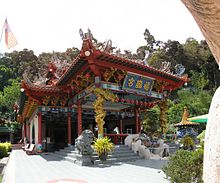Pangkor Island
Fishing Destination
Pulau Pangkor is an island off the coast of Perak in north-west peninsular Malaysia, reached by ferry from Lumut (a small coastal town that links to Ipoh, or from Sitiawan). It has a land area of only 8 square kilometers, and a population of approximately 25,000 islanders. It is heavily promoted as a low-key tourist destination by the Malaysian government, but fishing and fish products remain major industries.
History
Historically, Pangkor was a refuge for local fishermen, merchants and pirates. In the 17th century, the Dutch built a fort in an effort to control the Perak tin trade. In 1874, it was the location of a historic treaty between the British government and a contender for the Perak throne (The Pangkor Treaty), which began the British colonial domination of the Malay Peninsula.
Pangkor is famous for its fine beaches and a mix of low budget to 5 star accommodations. Teluk Nipah and Coral Bay on the north west of the island is extremely popular with travellers from Europe. The quality of sand in the Pasir Bogak Beach is far superior to that elsewhere on the island. The sand is golden brown, quite similar to most leading prime beaches. There are a few resorts in Teluk Nipah or Nipah Bay.
Since the 2004 Indian Ocean tsunami in Indonesia, Thailand and to a lesser extent the West Coast of Malaysia in December 2004, there have been fewer local tourists visiting Pangkor.
In 2006, a biotechnology centre, a joint venture of Global Hi-Q Malaysia S/B and Hi-Q Bio-Tech International (Taiwan) Ltd began operations with initial investments of RM100million (USD30m). Their operations include fish farming and aquaculture, and the first harvest is expected in 2009.
Just next to island of Pangkor, there is a smaller island called Pangkor Laut Island.
Tourist attractions
The main attractions in Pangkor Island are the beaches. Other attractions include:
- Pangkor Town
- Fishing Villages
- Fu Lin Kong Temple
- Kali Amman Temple
- Batu Bersurat and Tiger Rock
- Dutch Fort (Kota Belanda)
- The Tombs
- Tortoise Hill
Beaches
Pantai Pasir Bogak (Pasir Bogak Beach)
Teluk Nipah (Nipah Bay)
Of all the Pangkor beaches, Teluk Nipah or Nipah Bay is the most popular with foreign travelers, although it is still predominantly Malaysians who frequent this area. This beach is located a few kilometers north Pantai Pasir Bogak. Unlike other beaches, it has corals, sea cucumber and bird lovers can find the hornbill (Burung Enggang) on this beach.Teluk Nipah has 2 beaches: Nipah Beach and Coral Bay. Nipah Bay has a view of two small uninhabited islands called Pulau Giam and Pulau Mentagor.
As of March 2011, the northern end of Nipah Bay was under heavy construction. A sea-wall was being erected along much of the beach, and a series of concrete shop houses were going up all along the seafront, obstructing the ocean view from the road and greatly reducing the amount of beach front available for recreati
Giam Island is mostly interesting for snorkeling. The waters are shallow. There are lots of corals and fishes to see.
Transport
Accessibility and convenience of travelling by road and by air to Pangkor was progressively enhanced over the two years 2006–2008, because of the completion of the upgrading workings of Simpang Pulai – Lumut 4-lane dual carriage highway (which is nearing completion), the West Coast Expressway and the introduction of more flights, including AirAsia services. It is now possible to arrive at Lumut within 2–2¼ hours from Kuala Lumpur, and much less if it travelling by air.Currently Berjaya Air is the only airline that is operating flights to Pangkor Airport (PKG), from Sultan Abdul Aziz Shah Airport (SZB) with its 48-seats Dash 7 turboprop airliner. The aircraft are expected to be replaced by the ATR 72.
Buses from many parts of the country arrive frequently in Lumut at the bus station which is opposite the Lumut Jetty. Tourists are not allowed to bring their cars to the island; however, motorcycles and bicycles can be transported.
Ferry services are frequent (every 30 mins during the day, RM 10 for a return ticket). The ferry takes 40 minutes and stops first in Sungai Pinang Kecil. This has been well accepted as a special feature associated with commuting to and from Pangkor.
There are no bridges connecting the island to the mainland because there exists a policy to control the number of vehicles on the island, partly because of there being no real necessity for them and partly because of space constraints. All these have contributed to the preservation of wildlife in the tropical rain forest where many rare species still exist, including hornbills and monitor lizards.
- Article Source: http://en.wikipedia.org/
More Stories: http://blackboxfishtalk.blogspot.com/





No comments:
Post a Comment